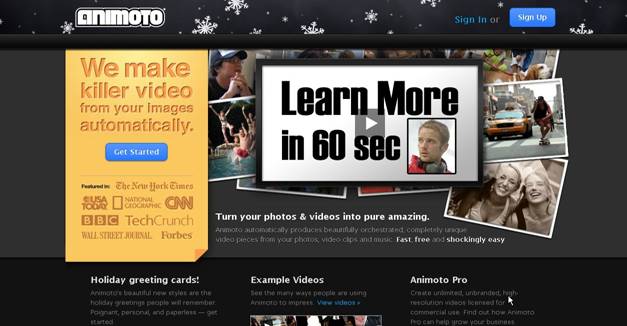Ken English
Social Media Marketing Consultant
English Plus Online
19832 Bobolink DriveMiami, FL 33015
Ph: 305-335-4857www.EnglishPlusOnline.com
Abstract
Most businesses recognize the importance of having a website. In the rapidly evolving world of the internet, having a static website is not enough. Today’s websites must be interesting, dynamic and easy to find. There are eleven key elements of social media you can use to get your website noticed. This presentation will focus on the four basic building blocks – audio, video, blogs, and micro-blogs – with the emphasis on how you can create a video using only a digital camera and a free video production site called Animoto.
Introduction
I’m going to take a few minutes to establish a timeline because I think it’s important you understand how quickly the internet has evolved, and that it is still evolving.
Think of this timeline as a highway, with each entrance ramp being a specific year. At some point, everyone listening to this presentation drove onto this information highway and become part of the traffic.
Where were you in 1962?
I know, that sounds like a long time ago, but that’s generally accepted to be the year the internet was born as researchers at MIT began to work on a concept to connect computers using the telephone infrastructure that existed at the time. Soon, military applications became evident, and the government entered the picture.
Where were you in 1972? I ask because that was the year the first email was sent. It was also the year of Watergate, and the attack on Israeli athletes at the Olympics. The average cost of a new house was $27,550. Average income? $11,800. Gas was 55 cents per gallon.
In 2009, there were 90 trillion emails sent on the internet. It is estimated that there are 247 billion, give or take a few, emails sent every day, including 200 billion considered spam. Research indicates more than 1.5 billion people use email on a regular basis.
Throughout the 70s and 80s, educational institutions worked on the process of sending information over phone lines, but it wasn’t until 1991 that a hypertext linking system was developed.
In 1993, a company called Netscape developed the first graphical browser. The following year, they began to market it.
In 1994, the World Wide Web Consortium was formed to provide common standards for all browsers because it was apparent the Internet was going to be important and standardization would assure access to a wide range of people.
AOL, Prodigy, and CompuServe began in 1995 as the Internet moved from the support of educational institutions and the government to commercialization. Instant Messaging began in 1996. Microsoft introduced Windows in 1998.
It’s generally accepted that social media (interactive communication) began with Classmates in 1995. Six Degrees, debuted in 1997, but failed in 2000. This interactivity became known as WEB 2.0, the second generation, and expanded with StumbleUpon in 2001, Friendster in 2002, MySpace and Linkdin in 2003, Flickr and Facebook in 2004. As the speed of the internet increased from a basic telephone line to broadband, the concept of a website began to change. No longer was it sufficient to have a brochure as your website, sitting there passively, waiting for someone to stop by.
While various forms of search engine technology were available in 80s, the turning point was 1996 when two Stanford University students began the process that would be incorporated as Google in 1998. At its peak in 2004, Google handled 84% of all search inquiries. Today, it’s the dominant player with over 50% of the search market. The remaining 50% is shared by Yahoo!, Bing/MSN and dozens of others.
YouTube began in 2005 by a couple of college students. It was acquired by Google in 2006 for 1.6 billion dollars. That was the year the social news revolution began with Digg, Reddit, Delicious, a bookmarking site and Twitter, which created a new category called micro-blogs. A micro-blog has a maximum character limit of 140.
In 2009, Foursquare became the first location-based website using a geo-targeting application.
The current trend continues to move away from static website pages and into the realm of real-time streaming and status updates – generally speaking, what’s happening now.
According to the PEW Research Center’s most recent survey, 14% of adult internet users have uploaded a video to the internet, a significant increase over the 8% estimate of 2007.
Today, one goal of a business is to have its website indexed by a search engine, most notably Google, and rank on the first page for relevant keywords. Having a website is not an option – it’s a necessity.
As of December 2009, there were nearly 234 million websites, which included 47 million new ones since the 2008 study. There are more than 130 million blogs. Internet users, estimated at 360 million at the end of 2000 were expected to top 2 billion by the end of 2010. In November of 2009, the number of Tweets exceeded 27.9 million per day. Remember, Twitter began in 2006.
Facebook now serves more than 260 billion page views per month, that’s over 6 million per minute or 37 trillion in a year. Facebook has more than 30,000 servers online, and is adding more. It now has 500 million registered users.
YouTube serves more than 1 billion videos per day. At the end of 2009, more than 12 billion videos were viewed on YouTube each month in the United States. The average internet viewer in the U.S. watches nearly 200 videos per month. More than 80% of internet users in the U.S. watch online video. According to a YouTube blog post on 10 November 2010, 35 hours of video are uploaded every minute.
A static website is not enough. It has to be dynamic, meaning content changes, frequently. A search engine algorithm seeks out new and relevant information. If information on a website hasn’t changed in 30 days, it is not considered new, although it would still be relevant. Search engine optimization is a combination of keyword density in the body, keyword use in the title and dynamic activity such as text, pictures, audio and video.
The ABCs of Media Mojo are the fundamental elements that will help your website be indexed quickly and ranked for longer periods of time. It’s not unusual to appear on Google’s first page, then be gone the next day.
There are eleven key elements of social media you can use to get your mojo working online. This presentation will focus on the four basic building blocks – audio, video, blogs and micro-blogs – but there are also online PR, article marketing, teleseminars, webinars, mobile and email marketing, which includes using an autoresponder, and something new called widgets.
The emphasis of this presentation will now be on how you can create a video using only a digital camera and a free video production site called Animoto.
During the presentation, I’ll introduce you to several free online services (they all have paid upgrade options) that will help you position yourself as an expert in your field. You begin by investing your time to understand how they work, then expand the options as you learn more about each service.
Remember, these are simply tools. They do nothing by themselves. Used in combination, they will result in better indexing and improved ranking of your website. Are you ready? Let’s go…
Discussion
A is for Audacity, an audio editor (www.audacity.sourceforge.net).
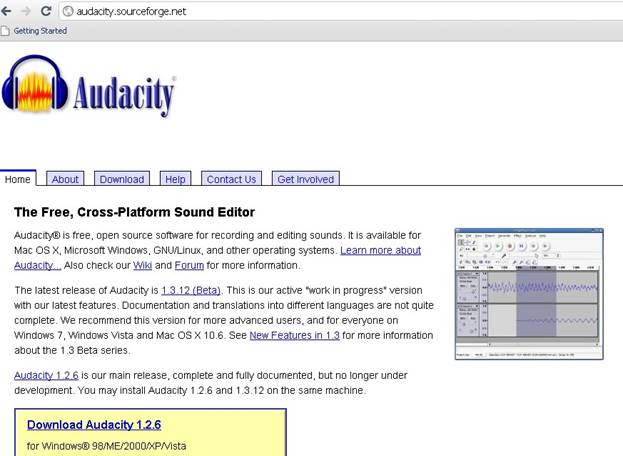
About Audacity
Audacity is a free, easy-to-use and multilingual audio editor and recorder for Windows, Mac OS X, GNU/Linux and other operating systems. You can use Audacity to:
• Record live audio
• Convert tapes and records into digital recordings or CDs
• Edit Ogg Vorbis, MP3, WAV or AIFF sound files
• Cut, copy, splice or mix sounds together
• Change the speed or pitch of a recording
• And more! See the complete list of features
About Free Software
Audacity is free software, developed by a group of volunteers and distributed under the GNU General Public License (GPL).
Free software is not just free of cost (like “free beer”). It is free as in freedom (like “free speech”). Free software gives you the freedom to use a program, study how it works, improve it and share it with others. For more information, visit the Free Software Foundation.
Programs like Audacity are also called open source software, because their source code is available for anyone to study or use. There are thousands of other free and open source programs, including the Firefox web browser, the OpenOffice.org office suite and entire Linux-based operating systems such as Ubuntu.
We welcome donations to support Audacity development. Anyone can contribute to Audacity by helping us with Beta documentation, translations, user support and by testing our latest code.
Ohloh has statistics on the value of Audacity development. The Ohloh “badge” at the bottom of each page on this site shows updated summary values. We set up the Ohloh pages about Audacity so the statistics show only the values of Audacity-specific development, excluding the third-party code libraries Audacity uses.
Animoto is a video maker (www.budurl.com/animojo). It has an upgrade option to produce video longer than 30 seconds, as well as exclude their branding, but you don’t have to pay to play as you learn how it works. I’ll go into detail on this platform in a few minutes.
Amplify is a social media site that enables the user to expand on various topics.
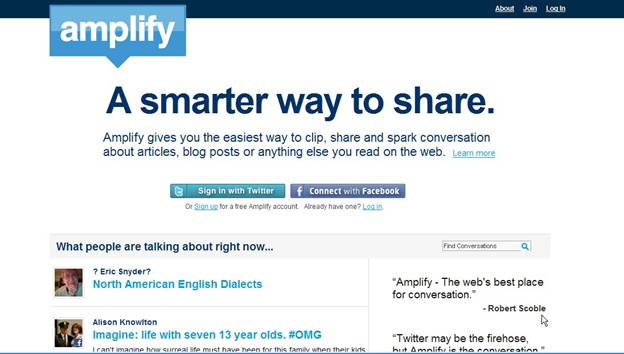
Amplify FAQ
What is Amplify? Amplify is a service for engaging in conversation about news, thoughts and ideas people share. Not all conversations can be had in fewer than 140 characters, so while Twitter is an amazing place for keeping up with what’s going on, Amplify is the place to talk about it.
Can I use Amplify to autopost to other services? Yes. Amplify’s list of supported sites includes social networks Twitter, Facebook, Google Buzz and Friendfeed; blogging services WordPress, Tumblr, Blogger and Posterous; as well as other services including Ping.fm, delicious, diigo and Plurk.
How can I use Amplify to curate and share news, images or videos I find on the web? Instead of just shortening URLs, Amplify gives you the easiest, most powerful way to clip, share and spark conversation around things you find on the web. You can use the Amplify bookmarklet in Firefox, Chrome, Safari, Opera and Internet Explorer. We also have a Firefox add-on and a Google Chrome extension.
Can I use Amplify to clip and share what I’m reading on my iPhone, iPad or Android iphone? Yep. To use Amplify on your iPhone, iPad or Android phone, visit http://www.amplify.com/bookmarklet and follow the instructions.
Can I use Amplify to post by email? Yes, every user is given a unique email address they can use to post things on Amplify (users with multiple Amplogs will be given a unique email address for each one). Whatever you provide as the email’s subject will become the post’s title. If you want to microblog, simply leave the subject line of your email blank. The body of your email will become the post’s content. Photos that are included (either inline or as attachments) will be included in your Amp (support for video will be added). Like all content shared on Amplify, anything posted by email can simultaneously be auto-posted to Twitter, Facebook, Google Buzz, FriendFeed, Tumblr, Blogger, Posterous, WordPress or any of our other supported services. However, if you want to turn autoposting off for a particular post, simply add “autopost off” in the first line of your email. Also, if you just want to exclude specific services from auto-posting for a particular post, add “autopost” followed by the specific services you wish to post to in the first line of your email. After your email has been posted on Amplify, you will get an email confirmation letting you know. To get your unique Amplify email address and see more complete instructions, visit Post By Email under Settings.
Why would I use Amplify if I’m already using other services like Twitter, Posterous, Buzz and Friendfeed? Funny you should ask. We’ve added our perspective on that here.
Can I setup Amplify to post to multiple Twitter accounts? Yep. Visit Settings >> Autopost and click Twitter on the left side of the page.
Can I setup Amplify to post to Facebook Pages (in addition to my personal Facebook profile)? Yep. Visit Settings >> Autopost and click Facebook on the left side of the page. You will then see the option to enable Facebook Pages on the right side of the page.
I want to post from Amplify to a Facebook Page using my Facebook Page name, not my personal Facebook name. Can I do that? After you click the check box to enable a Facebook Page, a Facebook dialog opens up asking if you want to allow Publishing to the Page. If you click Allow Publishing, all posts will be made as the Page Name. If you don’t allow publishing, the post will be made as your personal Facebook name.
Can I use Bit.ly for shortening URLs I share via Amplify? Yes, to set up Bit.ly on Amplify, visit your Settings page and under “More Settings” click Enable Bit.ly URLs.
How can I use Amplify to curate, share and discuss specific Tweets from twitter.com? From any feed on Twitter.com, click the Amplify button in your browser and then choose “Clip This Page” in the menu that opens. The orange Amplify lines will now easily surround any Tweet that you scroll your mouse over. Click inside the orange lines to select any Tweet(s) you want to Amplify. T he formatting of the Tweet, including the user’s profile picture on the left, will be preserved in your Amp.
Can I use Amplify to clip and share things I read in Google Reader? Yes, Amplify supports clipping and sharing from Google Reader. Also, please note that when you clip something from Google Reader, the source URL of your post on Amplify will link directly to the original source, not Google Reader.
How can I set up Google Buzz to scrape my Amplify page? If you want the full content and formatting of all your Amps to be posted to Google Buzz, instead of using Amplify’s auto-post feature, you can set up Buzz to scrape your Amplify page. To do that, on Amplify go to Settings >> Customize Your Sidebar and then activate the Where to Find Me widget and add Google Buzz as an item. Then add a link to your Amplify page on your Google profile and then add Amplify as a Connected Site in Buzz. From then on, when Google recrawls your Amplify page it will include your latest posts on Buzz.
If I have multiple Google Buzz accounts, how can I choose which one to link with Amplify? When linking Google Buzz, Google will use whichever Google account you are currently logged into. If you are not logged into Google, you will get a Google login screen, where you can chose whichever Buzz account you like. If you are logged into Google, the user/email of the account will appear in the upper right hand corner of the Google page you get redirected to when linking Buzz to Google. There is a sign out link right next to it, if you would want to link a different account.
I see that I can write microblog posts on Amplify that exceed 140 characters. What happens if I post them to Twitter? When you write a microblog post on Amplify that exceeds 140 characters and post it to Twitter, we automatically truncate your Tweet and add “(cont)” plus a link to your full post at the end. If your post is under 140 characters, then it gets posted to Twitter exactly as is.
Do I need to create an account to use Amplify? Yes, but you can by signing in via a Facebook or Twitter account. All you’ll be asked to do is choose a URL of your Amplify page and supply a valid email address. If you don’t want to sign up with your Facebook or Twitter account, you can easily create a free Amplify account. Join now
The Amplify Firefox extension seems to have disappeared from my browser. What can I do to get it back? To get the Amplify button back in Firefox, click View >> Toolbar >> Customize. Then, in the window that opens scroll to the bottom and look for the Amplify icon. If you see it, drag it from the window back to the top of Firefox wherever you want it located. We’re looking into a more permanent solution to preventing this from happening, but this should restore it.
Can I use Amplify to share videos I find on the web? Yes. With the Amplify bookmarklet, you can Amplify online video from sites including YouTube, CNN, WSJ, Reuters, CBSNews, The Daily Show, CNet, Ted.com, Blip.tv, Vimeo and many others.
I have edited my Amplify Profile but it keeps changing or disappearing. If you signed up for Amplify using a Twitter account, your profile information and photo are automatically pulled from Twitter each time you login to Amplify. If you want to override this, you can visit Settings >> Edit Your Profile and provide new profile information. Just be sure to check the box at the bottom of the page that says “Use the profile info above instead of automatically pulling from my Twitter profile”.
Can I approve new followers on Amplify? Sure, if you want to approve who can follow you on Amplify, visit Settings >> Privacy and check the box that says “Yes, I want to approve who can follow me”.
How can I block people from following me on Amplify or commenting on my Amps? To block someone from following you or commenting on your Amps, visit their Amplify page and click the “block” link in their profile widget.
What’s the difference between a Direct Message and a general comment on Amplify? General comments are public for anyone to see while Direct Messages let you engage in private conversations with other users on Amplify. You can only send direct messages to users who follow you.
Is Amplify free? Yes, all aspects of Amplify are free. .
I see that Amplify also supports groups. Explain. Amplify can be used by businesses, organizations, classrooms or any other group to create a community web site for members to share and discuss what they’re reading on the web. Amplify groups can be synced with Twitter and Facebook as a way for organizations to have a meaningful presence on the social web or they can be kept private within the enterprise to facilitate shared knowledge and communication around what members are reading on the web.
How can I remove myself from a Group Amplog that I’ve joined? To remove yourself from a group go to Settings => Start a New Amplify. On that page, you will see a list of Amplogs that you’re a part of with a Remove link next to each one.
B is for BlogTalkRadio, a podcasting system that began in 2006 (www.blogtalkradio.com).
BTR is considered by search engines as an authority site, which means content is indexed quickly, because independent producers generate more than 1000 shows per day.
BTR also provides a blogging element which helps with promotion, along with a widget that can be placed on different websites and blogs, which helps to develop listeners. It’s free to setup and do a 30 minute internet radio show each day, talking about your product, service or favorite cause. A free account is restricted to non-prime time – 7 PM to 11 PM – but you have the rest of the day, seven days a week to choose from.
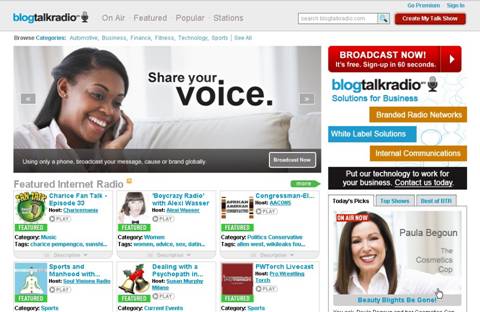
When you visit the website, scroll to the bottom of the page and click on the FAQ link and you will likely find the answer to any questions you may have.
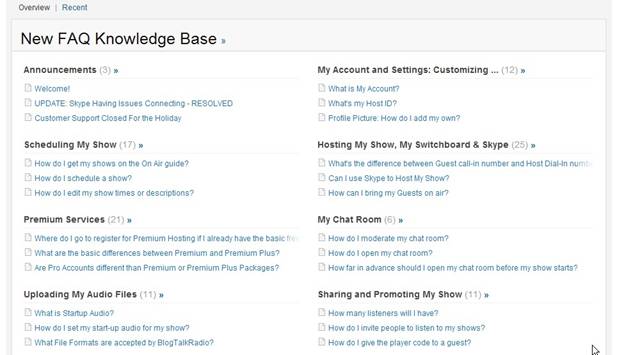
Blogs are text-based services that enable you to tell your story, a little at a time, in words, pictures, video and audio. WordPress (www.wordpress.com) and Blogger (www.blogger.com) are free platforms, with WordPress being more involved and offering expanded elements, such as unique themes for a price and a wide range of plug-ins.
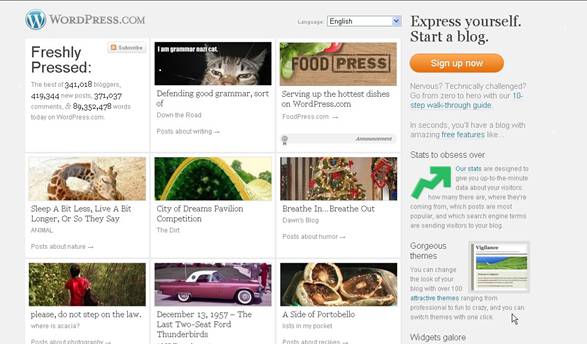
Blogger is easy to use, and since it’s owned by Google, some people feel it has a better shot at being indexed. Both work extremely well. The key, of course, is content. Remember, someone has to produce text, pictures, audio and video.
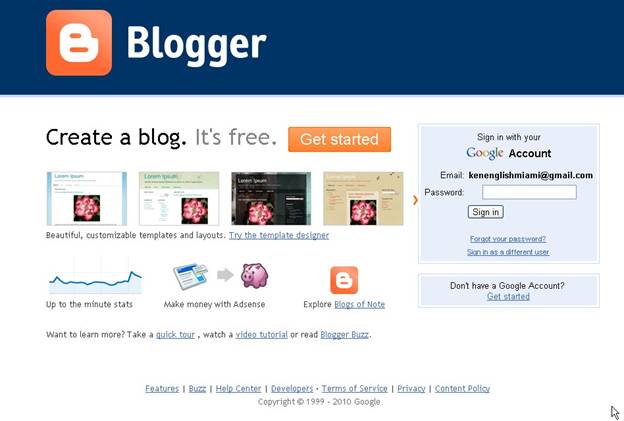
Also in the blogging category are micro-blogs, such as Twitter (www.twitter.com).
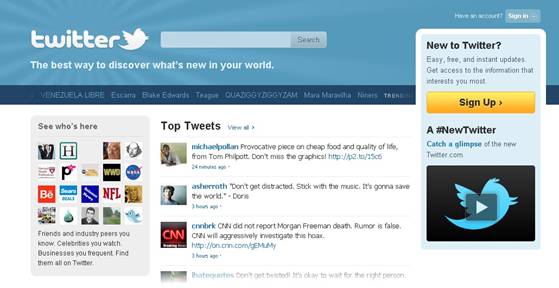
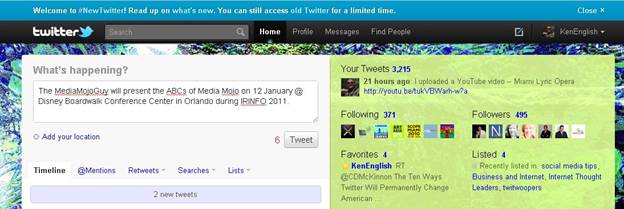
and Cinchcast (www.cinchcast.com).
Each has a 140-character limit to each post, but Cinchcast is based on audio, so the text is used to tell people that you have said something, and encourage them to listen.
C is for Cinchcast (www.cinchcast.com), a micro-blog with an audio element.
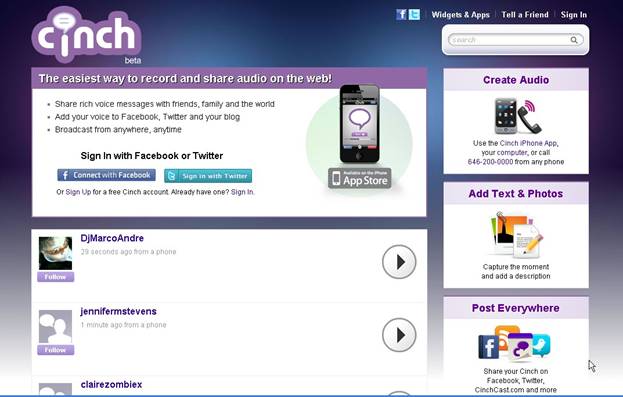
Cinchcast is a free audio blogging system from BlogTalkRadio. You signup by registering a phone number, then call a computer in New York City and record a message. The message is converted to a mp3 audio file, which is first heard on Cinchcast.com. Similar to Twitter, people follow you, so they are notified when you post a message. You can download and edit the file with Audacity, or any audio editor. Then upload and use it as part of a BlogTalkRadio show, or as the soundtrack for an Animoto video. Capturing your screen is one way to create a video or produce a PowerPoint presentation.

After recording, add a description, include a full URL to create a hyper-link. The file is played by clicking the arrow, or you can link or embed by placing your mouse over the image. From inside the account, you can download and edit the file for use as part of a video, or BTR show.
CamStudio (www.camstudio.org).
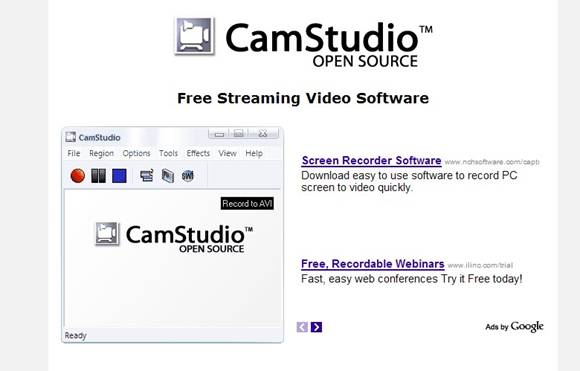
Other screen capture systems include: Jing (www.jingproject.com),
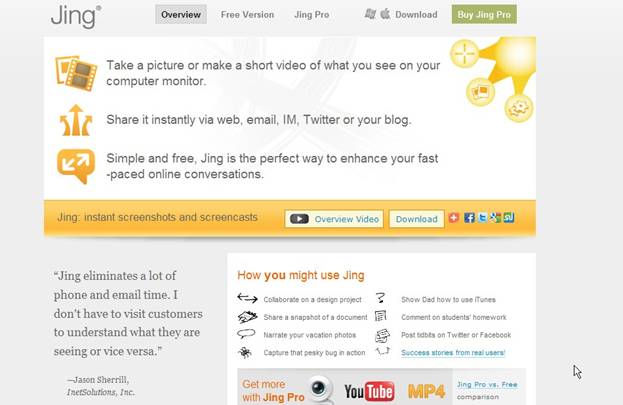
CaptureFox (www.capturefox.com)
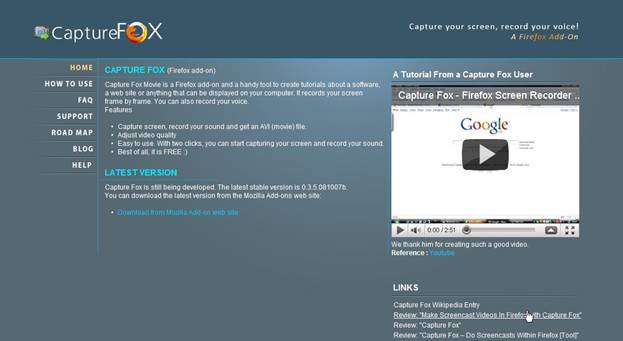
Screen Hunter (www.screenhunter.com).
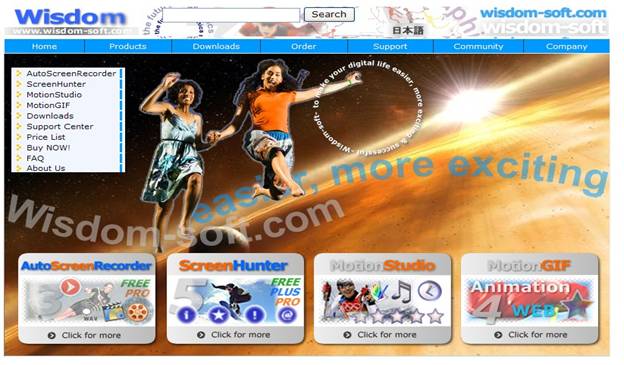
WebKut is useful for capture All of the Page, as well as smaller portions (www.toki-woki.net/p/WebKut/). When you see a tall screenshot (like the YouTube one you will see in a moment), this was the tool that was used.
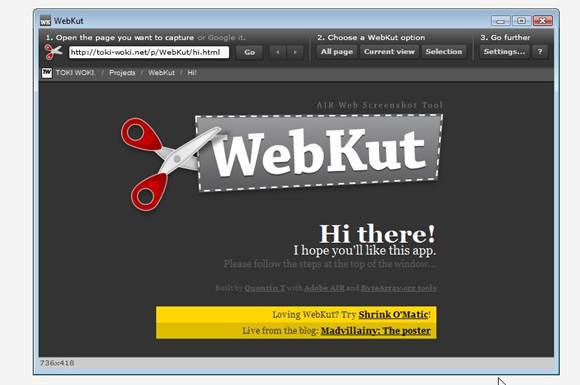
While audio and text are indexed, video is the most powerful social media element.
Video is more effective because it involves more senses, but it also looks and sounds like TV, a communication element that people are familiar with.
Remember, visual quality is a function of the viewer’s monitor resolution and bandwidth, but the ease of use and variety of content appeal to people of all ages.
YouTube is the dominant general interest user-generated video platform, but there are dozens of others serving special-interest niches, from How-to videos to music, travel and adult themes.
To name a few:
– www.dailymotion.com
– www.metacafe.com
– www.vimeo.com
– www.viddler.com
– www.blip.tv
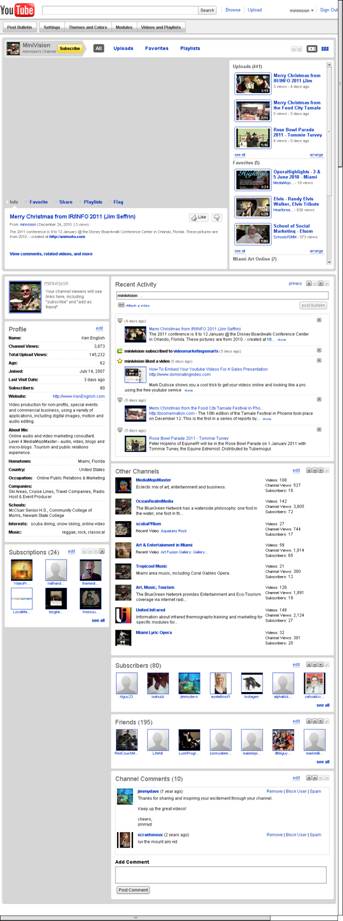
There are sites that aggregate information from various sources, such as Google Alerts and Vodpod.
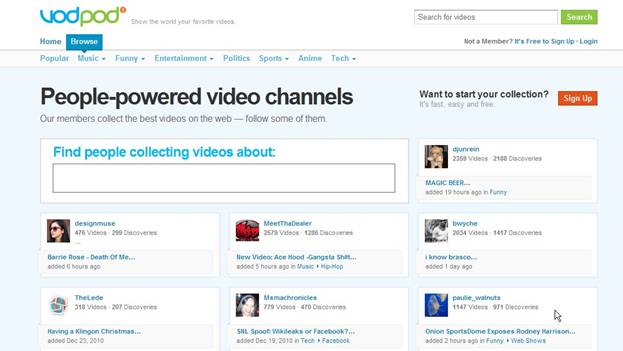
as well as sites that distribute information to multiple destinations, such as Ping.fm (www.ping.fm),
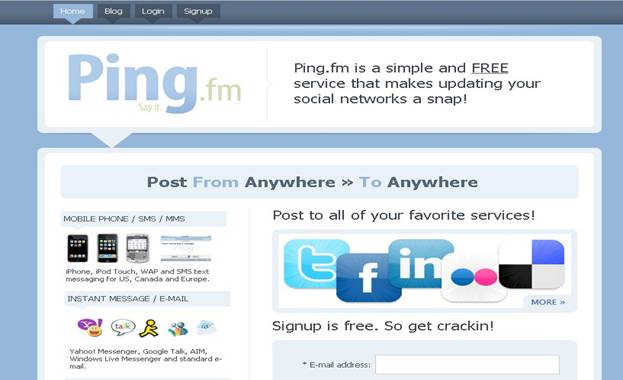
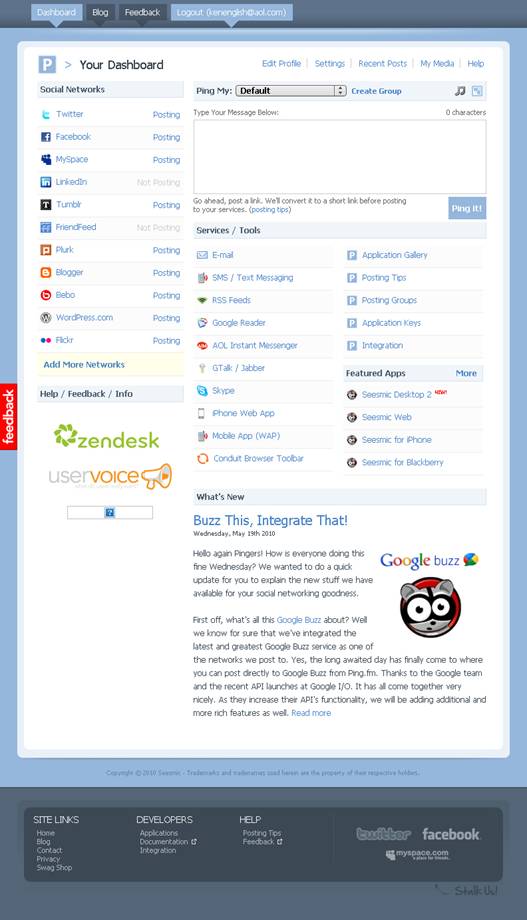
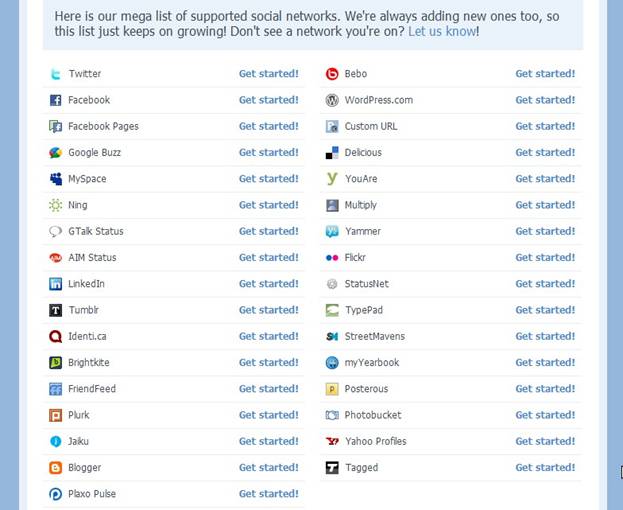
Tubemogul (www.tubemogul.com)
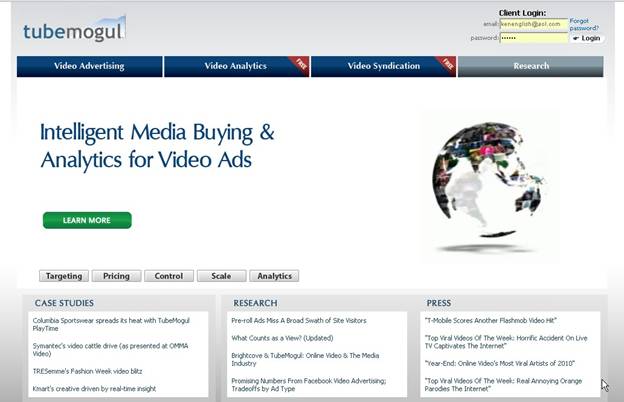
Pixelpipe
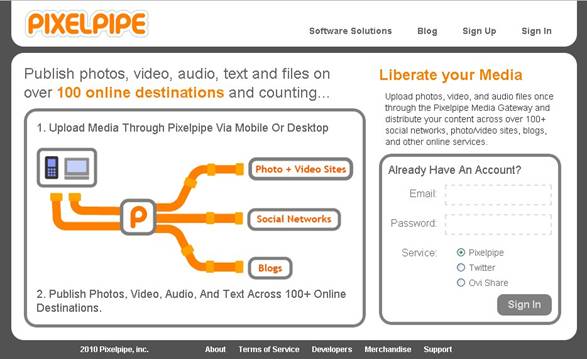
In addition to audio, video, blogs and micro-blogs, Media Mojo includes, but is not limited to,
– online PR
– article marketing
– teleseminars
– webinars
– mobile marketing
– email marketing
– widgets (www.widgetbox.com)
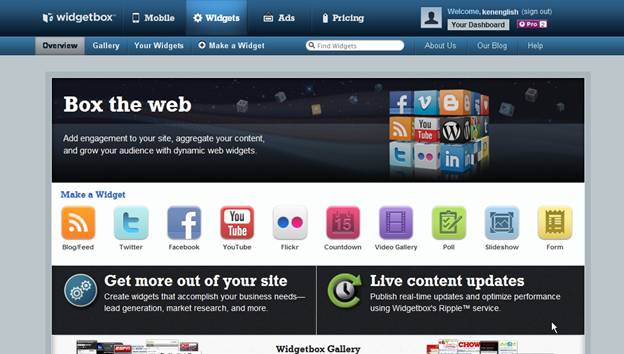
Social Media is relationship marketing that starts with ME.
It requires a different attitude than existed in the past. It’s not difficult to learn, but it can be time-consuming. There are ways, however, to implement, what Dr. Ron Capps, aka the Nicheprof, refers to as an “economy of action.”
The most important element is an open mind.
You have to recognize things are constantly changing, and they will continue to do so because social media is evolving. Several of the sites mentioned above failed because they were not able to adapt to the changing marketplace. New sites took their place. Nearly every day, a new social media concept is introduced in Alpha or Beta mode. Some never get beyond the testing phase, but some become
– Facebook with 500 million users
– Twitter with 100 million users
– BlogTalkRadio with 1000+ people doing an internet radio show each day
– YouTube with billions of daily views worldwide and 35 hours of content uploaded every minute of the day
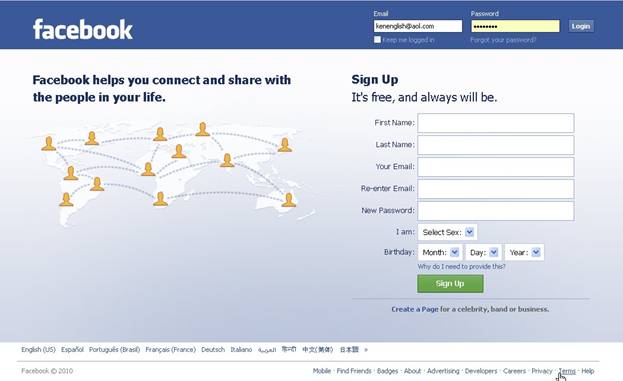
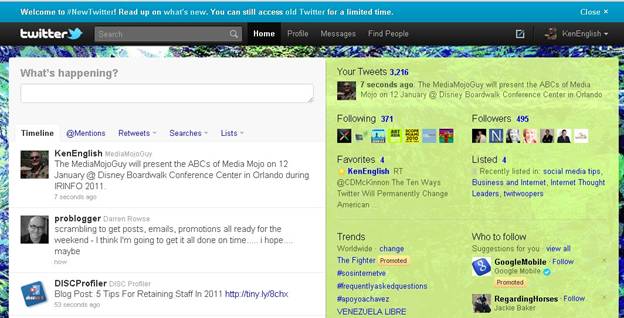

While social media is the overall theme, video is the focal point of my presentation. If you listen to what I have to say, really listen to what I have to say, you will understand this is something you can, and should do. You can, of course, choose to ignore this information and continue doing business the way you have been doing it, and, in all likelihood, getting the same results.
Or, you look closely and see how you can incorporate some of these suggestions into your marketing for 2011, and beyond.
During this portion of the presentation, I will demonstrate how to use pictures you take with a digital camera, mix them with royalty-free music and create a video, which can be pushed to your YouTube channel, posted on Facebook, linked on Twitter and dozens of other social media sites.
YouTube videos can be placed (embedded) on your website or blog.
You can share it with people via dozens of social media sites, if you establish a free account with each, by clicking a couple buttons on the Animoto and/or YouTube sites.
If you know how to take digital pictures and get them on your computer, then you can make promotional videos with music.
With a little effort, you can do a voice-over and make a 30-second sales video that can be placed on YouTube, your website or blog – for free.
Animoto: www.budurl.com/animojo
Landing page.
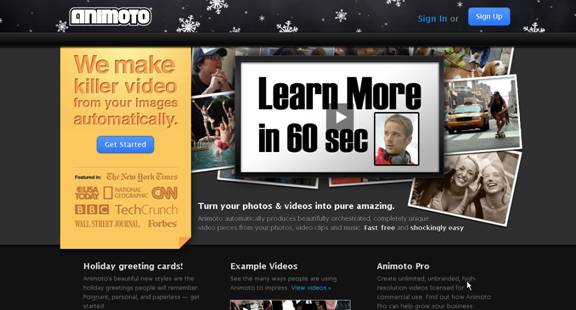
There are three plans.
– The Basic Plan is free. You get a 30 second video anytime you want, which includes 10 to 12 images and text blocks with background music. The video ends with the Animoto logo.
– All Access gives you as much time as you want, but the video ends with the Animoto logo.
– The Pro Plan produced HD video with no branding. See next slide for more details.
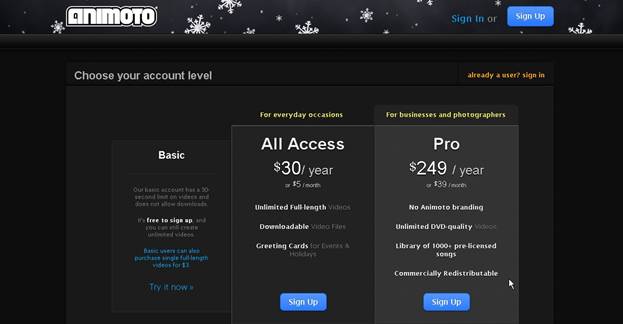
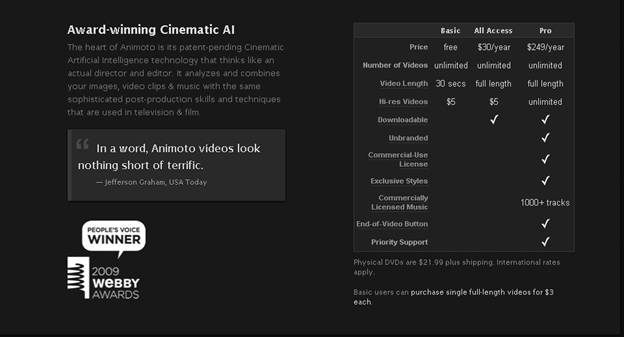
Click Sign Up or Try it Now for a free account and fill in the blanks.

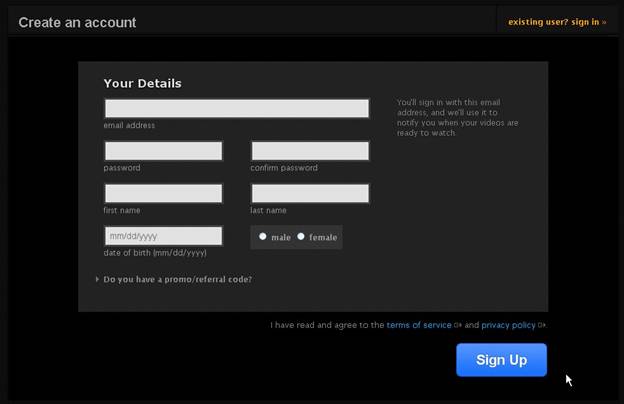
When you have an account, you Sign in.
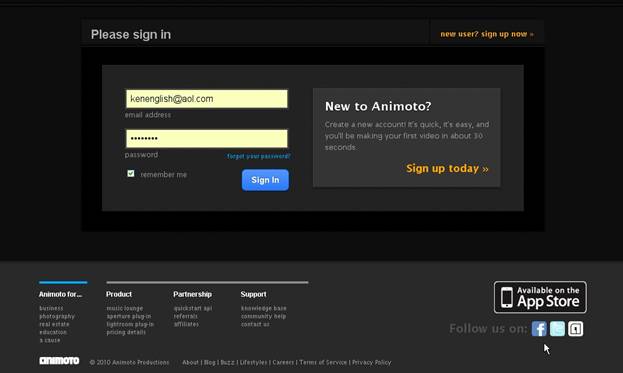
First step: adding images and video snippets (less than 20 seconds).
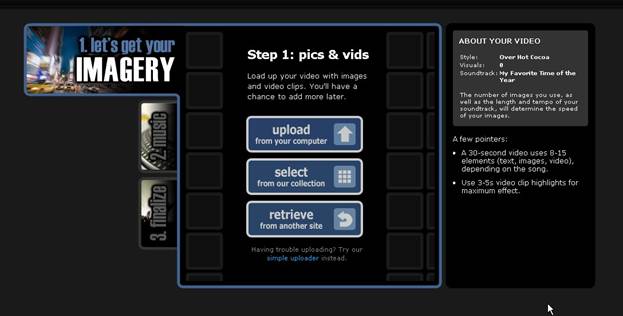
You can use free images and video, but they won’t tell your story.
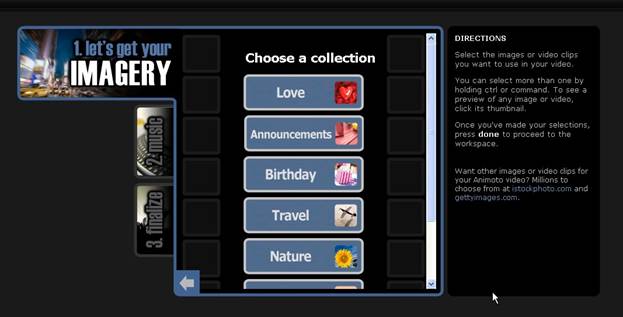
t’s best to select images that reflect your specific business. You can get them from your computer or photo services you have an account with.
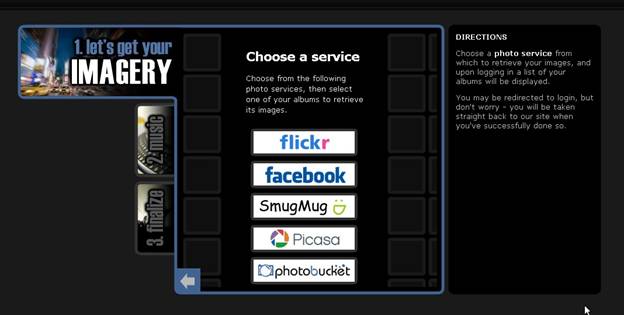
From your computer, simply find the images and click to select.
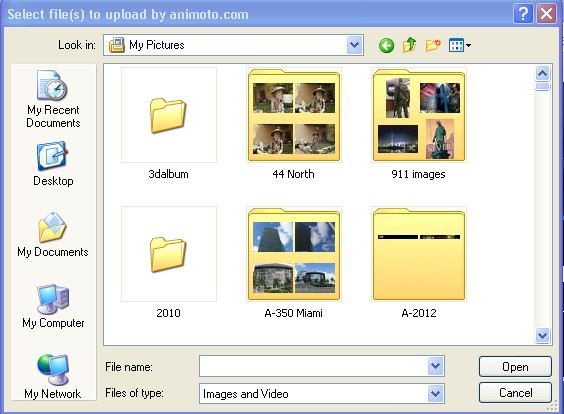
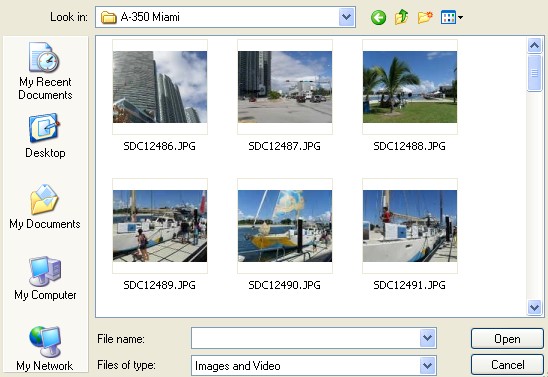
The pictures will be uploaded into the Image Gallery on Animoto.
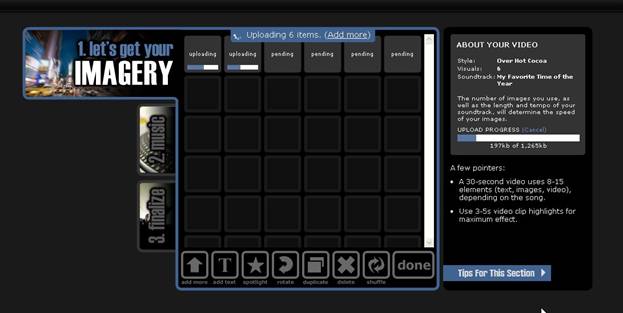
At the bottom of the Gallery are several options:
– Add more images
– Add text
– Spotlight an image (doesn’t work on text)
– Rotate
– Duplicate
– Delete
– Shuffle
– Done

Add text enables you to place a Headline (title) and Subhead before an image
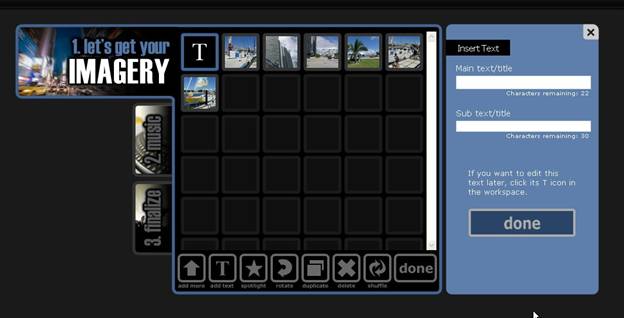
There are limitations for both text boxes.

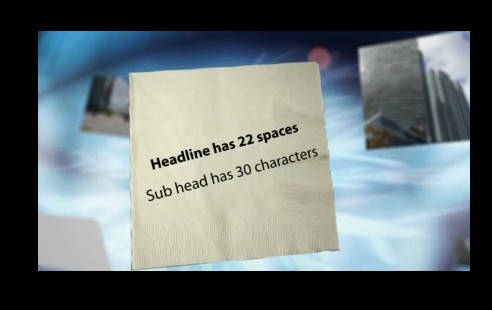
Spotlight slows the transition time, so the image stays visible longer than other images.
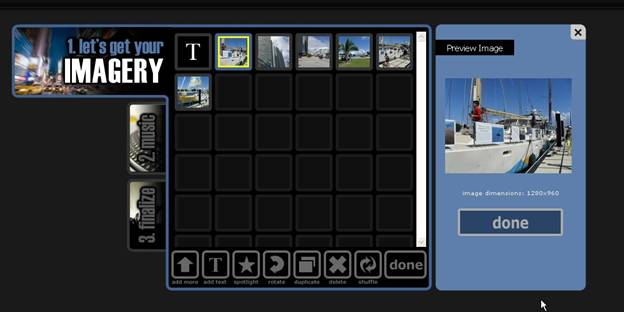
Adding audio.
You have a choice of using royalty-free music supplied by Animoto, or uploading your own music file (mp3). You can add a voiceover if you mix the file using an audio editor, saving the file and uploading by clicking – change your soundtrack.
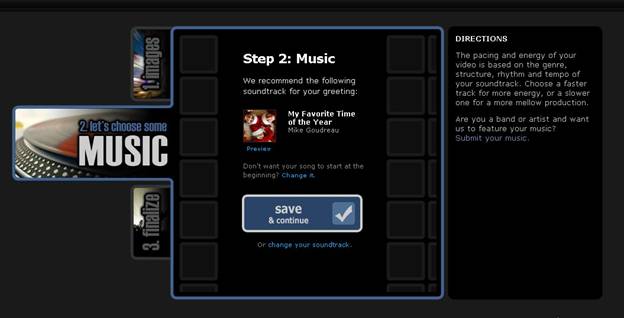
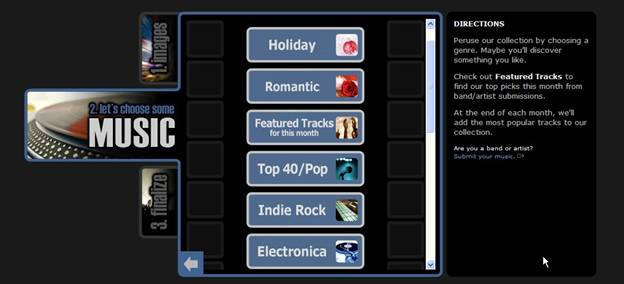
Using your own mp3, you will upload it to the Animoto system.
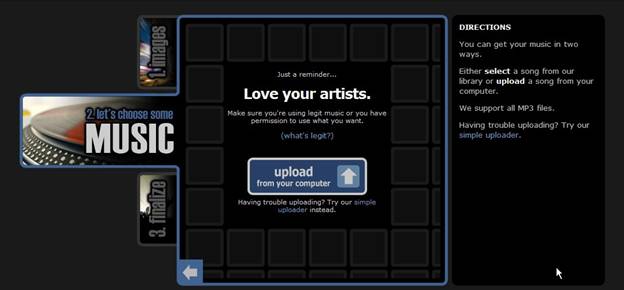
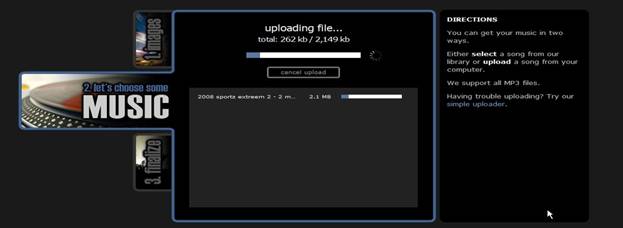
There are several Background Options, beginning with Black. Many are free, but some require the PRO upgrade. Once you have determined the background you want, click Select This Style.
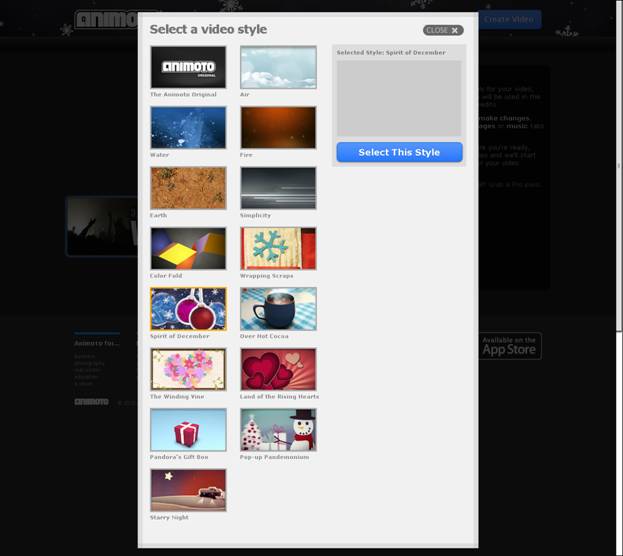
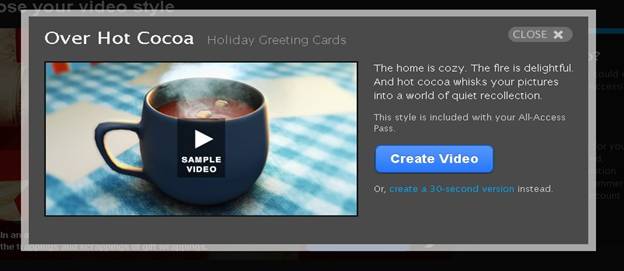
You have some control over the way the video displays.
The middle (default) setting uses transitions timed to the music. 1/2 speed will lengthen the video. 2X speed will shorten it. To change the background, click – change – and select again. Click Continue for the next screen.
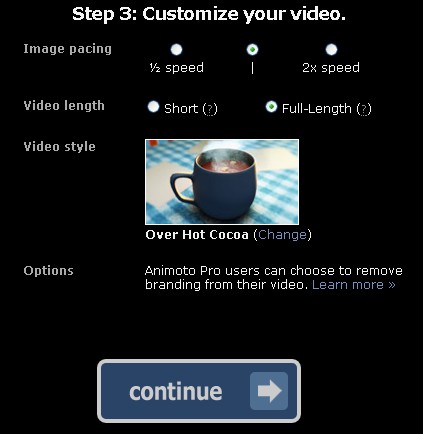
Describe your video.
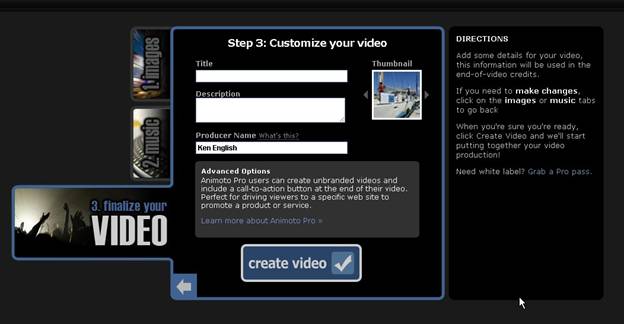
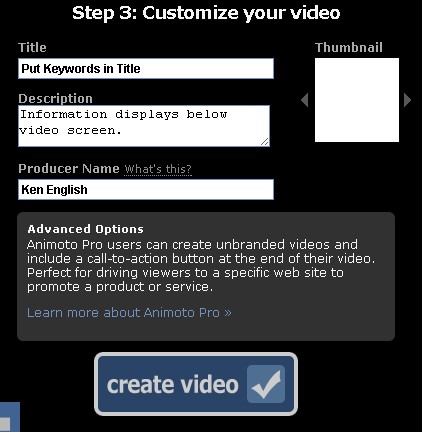
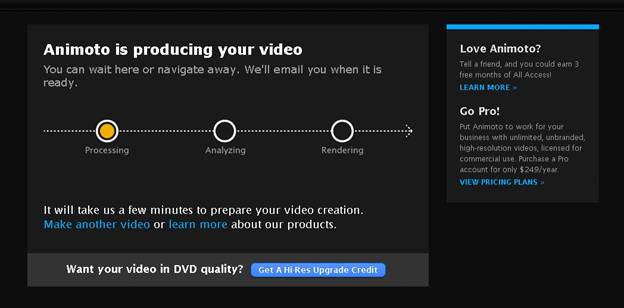
You are notified by email when your video has finished rendering.

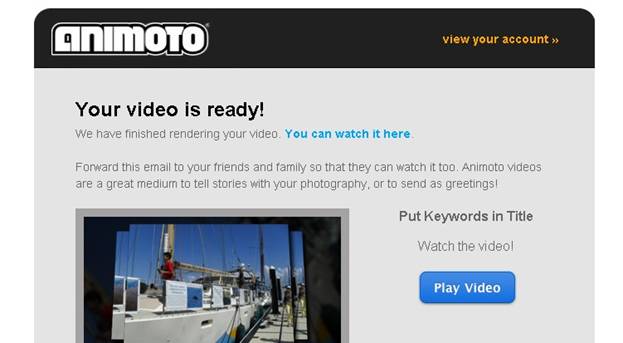
Example of information display.
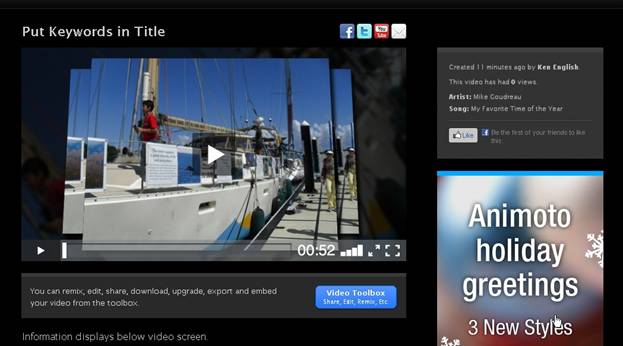
Archives of produced videos.
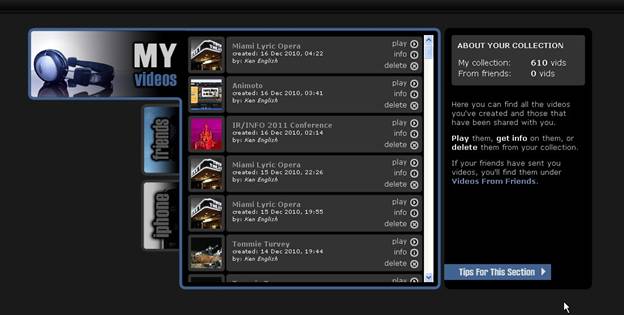
Administration Panel.
– Share
– Embed
– Export
– MP4
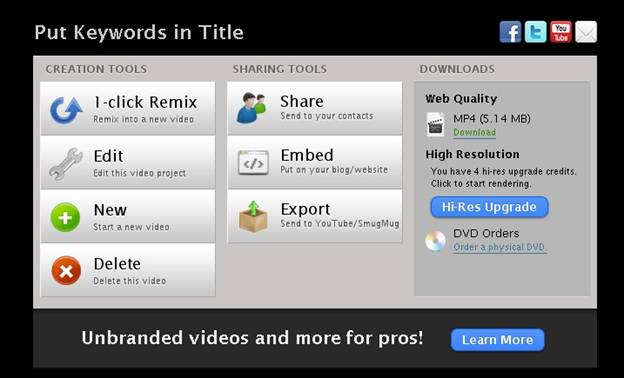

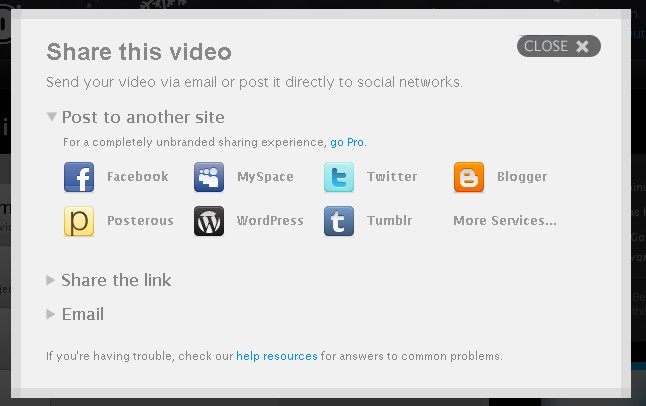
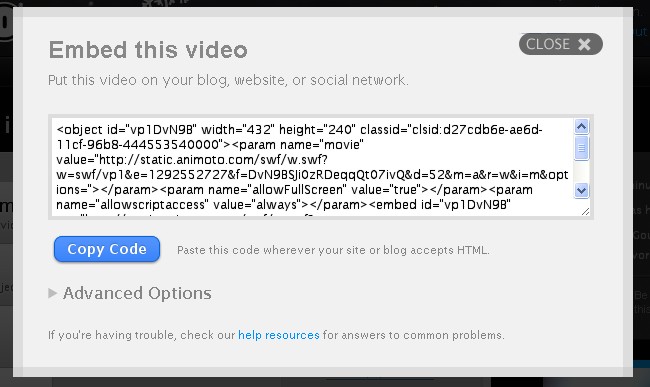
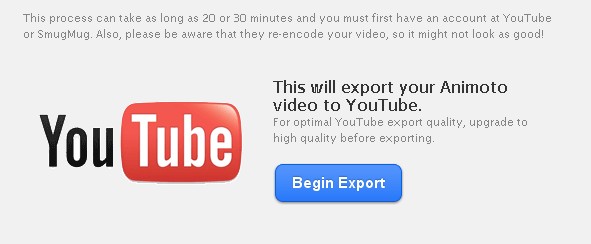
Contact Information
Email:
Phone: 305.335.4857
Check out
Blogs
www.mediamojoguy.com
http://kenenglish.wordpress.com
Websites
www.englishplusonline.com
www.englishpublishing.com
www.kenenglish.com
Social Media


